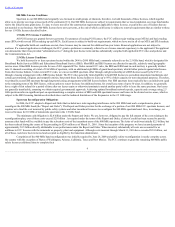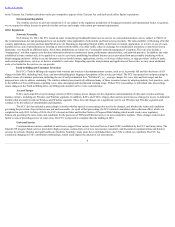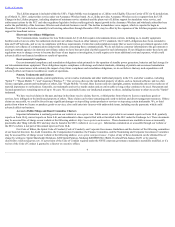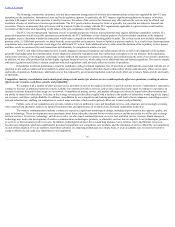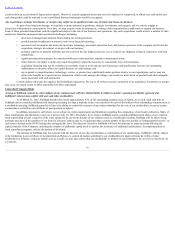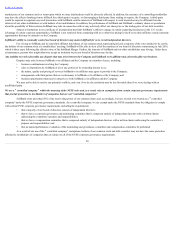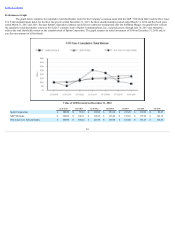Sprint - Nextel 2015 Annual Report Download - page 18
Download and view the complete annual report
Please find page 18 of the 2015 Sprint - Nextel annual report below. You can navigate through the pages in the report by either clicking on the pages listed below, or by using the keyword search tool below to find specific information within the annual report.
Table of Contents
The licensing, construction, operation, sale and interconnection arrangements of wireless telecommunications systems are regulated by the FCC and,
depending on the jurisdiction, international, state and local regulatory agencies. In particular, the FCC imposes significant regulation on licensees of wireless
spectrum with respect to how radio spectrum is used by licensees, the nature of the services that licensees may offer and how the services may be offered, and
resolution of issues of interference between spectrum bands. The FCC grants wireless licenses for terms of generally ten years that are subject to renewal and
revocation. There is no guarantee that our licenses will be renewed. Failure to comply with the FCC requirements applicable to a given license could result in
revocation of that license and, depending on the nature of the non-compliance, other Sprint licenses.
The FCC uses its transactional "spectrum screen" to identify prospective wireless transactions that may require additional competitive scrutiny. If a
proposed transaction would exceed the spectrum screen threshold, the FCC undertakes a more detailed analysis of relevant market conditions in the impacted
geographic areas to determine whether the transaction would reduce competition without offsetting public benefits. The revised screen now includes substantial
portions of the 2.5 GHz band previously excluded from the screen and that are licensed or leased to Sprint in numerous markets. As a result, future Sprint spectrum
acquisitions may exceed the spectrum screen trigger for additional FCC review. Such additional review could extend the duration of the regulatory review process
and there can be no assurance that such transactions will ultimately be completed in whole or in part.
The FCC and other federal agencies have recently engaged in increased regulatory and enforcement activity as well as investigations of the industry
generally. Depending upon their interpretation, newly adopted net neutrality regulations may have unforeseen consequences for our business. Such regulations,
enforcement activities, or investigations could make it more difficult and expensive to operate our business, and could increase the costs of our wireless operations.
In addition, we may offer products that include highly regulated financial services, which subject us to additional state and federal regulations. The costs to comply
with such regulations and failure to remain compliant with such regulations could adversely affect our results of operations.
Degradation in network performance caused by compliance with government regulation, loss of spectrum, or additional rules associated with the use of
spectrum in any market could result in an inability to attract new subscribers or higher subscriber churn in that market, which could adversely affect our revenues
and results of operations. Furthermore, additional costs or fees imposed by governmental regulation could adversely affect our revenues, future growth, and results
of operations.
Competition, industry consolidation, and technological changes in the market for wireless services could negatively affect our operations, resulting in adverse
effects on our revenues, cash flows, growth, and profitability.
We compete with a number of other wireless service providers in each of the markets in which we provide wireless services. Competition is expected to
continue to increase as additional spectrum is made available for commercial wireless services, and we have experienced and expect to continue to experience an
increased customer demand for data usage on our network. Competition in pricing, service, and product offerings may adversely impact subscriber retention and
our ability to attract new subscribers. A decline in the average revenue per subscriber coupled with a decline in the number of subscribers would negatively impact
our revenues, cash flows, and profitability. In addition, consolidation by our competitors and roaming partners could lead to fewer companies controlling access to
network infrastructure, enabling our competitors to control usage and rates, which could negatively affect our revenues and profitability.
Further, some of our competitors now provide content services in addition to voice and broadband services, and consumers are increasingly accessing
video content from alternative sources via Internet-based providers and applications, all of which create increased competition in this area.
The wireless communications industry continues to experience significant technological change, including improvements in the capacity, quality, and
types of technology. These developments cause uncertainty about future subscriber demand for our wireless services and the prices that we will be able to charge
for these services. As services, technology, and devices evolve, we also expect continued pressure on voice, text, and other service revenues. Rapid changes in
technology may lead to the development of wireless communications technologies, products, or alternative services that are superior to our technologies, products,
or services, or that consumers prefer over ours. In addition, technological advances have caused long distance, local, wireless, video, and Internet services to
become more integrated, which has contributed to increased competition, new competitors, new products, and the expansion of services offered by our competitors
in each of these markets. If we are unable to meet future advances in competing technologies on a timely basis, or at an acceptable cost, we may not be able to
compete effectively and could lose subscribers to our competitors.
16


